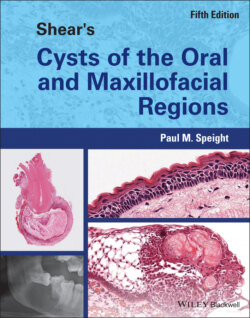Читать книгу Shear's Cysts of the Oral and Maxillofacial Regions - Paul M. Speight - Страница 44
Pathogenesis
ОглавлениеFor any type of cyst to develop, three elements are needed: a source of epithelium, a stimulus for epithelial proliferation, and a mechanism of growth and bone resorption. In the case of a radicular cyst, the process is driven by an inflammatory response at the apex of a tooth (Box 3.3). Although trauma, instrumentation, and irritation from filling materials may cause inflammation, in reality this is usually short lived and the chronic inflammation needed to initiate cyst formation almost always follows microbial infection in a dead pulp following caries. The presence of bacteria and their products in the root canal then leads to periapical inflammation and the formation of a periapical granuloma, which may then lead to cyst formation.
It must be noted, however, that although cysts are a direct sequela of periapical inflammation, cyst formation is not inevitable and radicular cysts are in fact quite rare relative to the prevalence of caries and periapical lesions. In an analysis of 256 periapical lesions, Nair et al. (1996 ) showed that only 15% were actually cysts, although a further 37% were granulomas with proliferating epithelium. Their criteria for diagnosis of a cyst was unusually stringent and depended on the ability to examine, in multiple serial sections, the entire specimen and to be able to visualise a distinct epithelial‐lined cavity. Few studies have undertaken such meticulous examination of lesions using serial sections, but those that have have confirmed the findings of Nair et al. (1996 ) that cysts form the minority of periapical lesions. The actual frequencies reported have been 17.1% (Simon 1980 ), 15.2% (Nair et al. 1996 ), 32.0% (Ricucci et al. 2006b ), and 24.2% (Ricucci et al. 2020 ).
